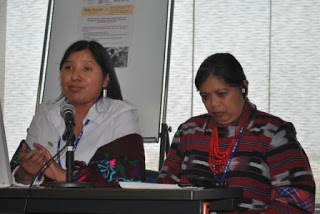
On October 18 at the 10th Conference of the Parties (COP 10) to the Convention on Biological Diversity (CBD), Natural Justice attended a side event co-hosted by the Forest Peoples Programme and Secretariat of the Convention on Biological Diversity on community experiences with Article 10(c) of the CBD. The event began with a short film on customary uses of forest resources and difficulties with the Forestry Department in the Sundarbans, Bangladesh. Viviana Figueroa (SCBD) noted that there are huge gaps in the implementation of Article 10(c) and that Parties must recognize the relationship between customary law and natural resource management and the centrality of 10(c) to communities’ livelihoods. Joji Carino (Tebtebba and IIFB) explained that at COP 10, “sustainable use” will be dealt with by Working Group I under Agenda point 6.7 on October 19. The Decision under review at COP 10 regards the inclusion of “a new major component on Article 10 with a focus on Article 10(c) on sustainable use and customary sustainable use of biodiversity”. Carino also noted that the Working Group on Article 8(j) and Related Provisions (WG8j) is expected to develop guidelines and a strategy for implementation of Article 10(c) at the national level and that there is a call for an international meeting on Article 10(c) to propose elements for a strategy for its implementation.
Community members from Suriname, Cameroon, Thailand, and Sundarbans (Bangladesh) presented their experiences with customary uses of biodiversity, threats, community control mechanisms, and local initiatives such as participatory mapping, video, and research, and conflict resolution negotiations with nearby communities and protected area managers. Their presentations underscored the critical need for communities to be able to fully exercise customary laws and sustainable use practices, as well as their importance to sustaining biodiversity and all of humanity. Questions and comments from the audience included: concerns about posting sensitive information about sacred sites on Google Earth; difficulties with differences between state and customary law; the need to ensure greater constructive collaboration with academia and researchers; the need to establish a legal framework for recognition of Indigenous Peoples’ and Community Conserved Areas (ICCAs) in Africa; and the great potential of tools such as participatory mapping to enhance dialogue between stakeholders and rights-holders. Carino closed the side event by noting plans to establish a network of Indigenous communities to share information and experiences with each other, to mainstream understanding of issues related to communities’ customary use of biodiversity, and to develop strategies for ways forward.









